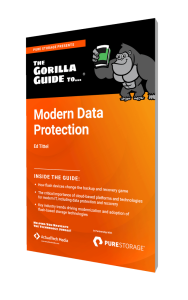New Release: The Gorilla Guide to…® Modern Data Protection

To suggest how much more complicated data storage has become in modern times, let me recall an incident from a conference I attended in the 1980s. Rob Pike, one of the central contributors to Unix, was introducing his new operating system, Plan 9 from Bell Labs. Everything was stored on a single optical disk. Pike said that would provide all the storage they ever needed.
Modern Data Protection lays out thoroughly and comprehensively the challenges and requirements of modern storage, backup, and recovery. For instance, author Ed Tittle warns that comparing the costs of on-premises storage with cloud storage is complex. But he goes further and lays out the elements of on-premises storage item by item.
Tittel’s report is a survey of how storage, backup, and recovery take advantage of the advanced approach to computing developed by modern programmers and administrators.
The high-speed, high-capacity digital networks of the twenty-first century, which were developed to serve applications such as ecommerce and streaming video, become your best friend when you need fast recovery from computer failures. Companies used to jury-rig systems for transferring data to tape and storing the tapes in a safe remote location. But today, given a nearly ubiquitous cloud, you can trigger automatic and routine data replication with a few clicks.
The “automate everything: approach popularized by DevOps has also reached backup and recovery. Tittle points out that if you need a recovery point objective (RPO) measured in minutes, you absolutely have to set up an automated system to recognize a failure and implement a failover solution. Containers, the modern architecture for applications, can also play a role in backup and recovery.
Modern Data Protection also promotes an end-to-end viewpoint, suggesting we talk more about “business protection” and less about “data protection.” Especially in a hybrid environment (Figure 1), an isolated recovery process has to be considered just part of a larger effort to restore business operations, including restarting applications and redirecting traffic to the new computer hosts.

The report ends with an in-depth look at the flash storage options from Pure Storage, which can drop in to your existing systems and processes.
Inside the Guide
Gorilla Guides make learning and discovery approachable and easy, and they take the guesswork out of navigating complicated IT technologies. Written by an industry expert, and brought to you by Hewlett Packard Enterprise, this resource is packed full of trusted information about data storage and flash solutions!
Download the book and learn all about:
- Adapting Modern Tools Such As Containers and Automation to Storage
- Detailed Requirements and Costs of Different Options
- Advantages of Flash Storage
Table of Contents
Introduction: The Importance of Business Resilience
Chapter 1: Setting the Stage for Protection and Recovery
- Legacy Systems Establish a Base
- The Cloud Changes Everything
- Flash-Based Technologies Rule
Chapter 2: Beyond Backup and Recovery
- The Old Backup and Recovery Mindset
- It’s Not About Speeds and Feeds
- It’s a Cloud World Now
- Ransomware on the Rise
- Today’s Recovery SLAs Are More Stringent
Chapter 3: Key Industry Trends
- Data Protection
- Hybrid Data Lives Everywhere
- Disaster Recovery
- Storage in the Cloud
- Pitfalls in Making Cloud Storage Work
- Beware of Ransomware
- Automation Is Key
- Recovery Time and Recovery Point Objectives
- Managing Changing Priorities
- Protecting a Work-from-Anywhere Workforce
Chapter 4: Pure Modern Data Protection
- Understanding Business-Centric IT
- The Importance of Availability
- Unified Fast File and Object
- The Value of Rapid Recovery
- Where SafeMode Snapshots Come into Play
- Becoming Cloud-Ready
- Maximizing Data Agility
Chapter 5: Real Customers, Real Cases
- City of New Orleans
- Domino’s Pizza
- Make the Most of Flash Storage
Download Your Copy!
About the Author
Ed Tittel is a 30-plus year veteran of the IT industry who writes regularly about cloud computing, networking, security, and Windows topics. Perhaps best known as the creator of the Exam Cram series of certification prep books in the late 1990s, Ed writes and blogs regularly for GoCertify.com, TechTarget, ComputerWorld, and other sites. For more information about Ed, including a resume and list of publications, please visit EdTittel.com.
About Pure Storage
Pure Storage gives technologists their time back. Pure delivers a modern data experience that empowers organizations to run their operations as a true, automated, storage-as-a-service model seamlessly across multiple clouds. Pure helps customers put data to use while reducing the complexity and expense of managing the infrastructure behind it. And our solutions help mitigate ransomware attacks with immutable snapshots and rapid, petabyte-scale recovery. Pure software and hardware solutions are easy to use and consistently evolving to better meet customer needs—without costly forklift migrations. For the past seven consecutive years, Gartner has named Pure a Leader in the Magic Quadrant for Primary Storage Arrays, and FlashArray and FlashBlade are 2021 Gartner Peer Insights Customers’ Choice winners. With a certified customer satisfaction score in the top one percent of B2B companies, Pure’s ever-expanding list of customers are among the happiest in the world.
Download your copy today!